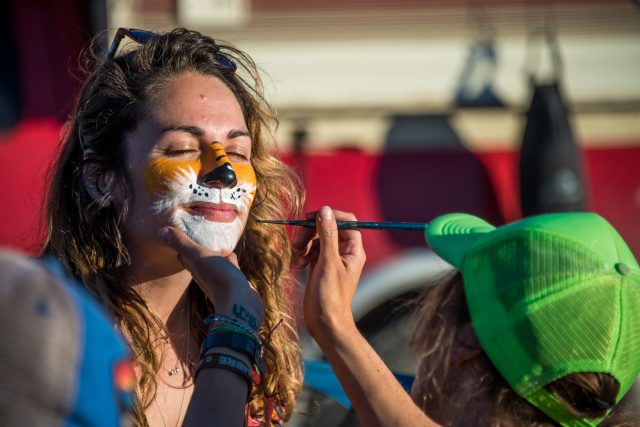No, I didn’t know diesel fuel gels when it gets too cold, preventing the van from starting. I did not find this to be common knowledge before this all went down. We should have probably thought things through a bit more or at least paid attention to the below-freezing temperatures the night before when the propane didn’t work, and our toes were purple. But this camping spot was so perfect. We were right next to a series of towering rock formations straight out of a Salvador Dali painting; they blocked the wind for us while we cooked dinner near the Árbol de Piedra on the Lagunas Route at an elevation of 4,570 meters. It was an excellent spot for the time to melt away.
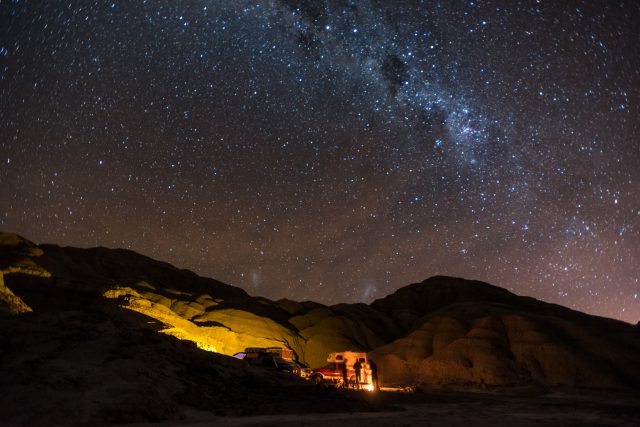
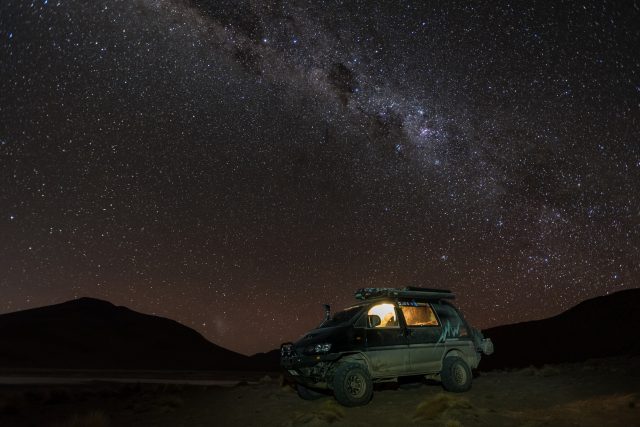
These same rocks cast a perfect shadow on our van the next morning. A long, dark, slow-moving shadow left the van in one of the only shaded, freezing spots in a giant open desert. When we woke, we saw that ice crystals lined the windows and had formed on the exposed metal near our heads. I remember the temperature said something crazy like -18°C inside the van. The water bottles, avocados, and onions were frozen solid, and big surprise, the van would not start. Not even a puff, a cough, a grind—nada. Just silence and the sound of our hearts dropping into our stomachs as our nerves escalated. We were on day three of a five-day drive in the Bolivian High Plains, and our house on wheels was not going anywhere.
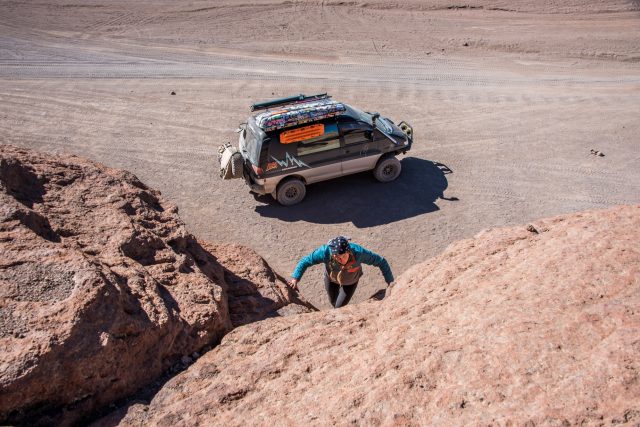
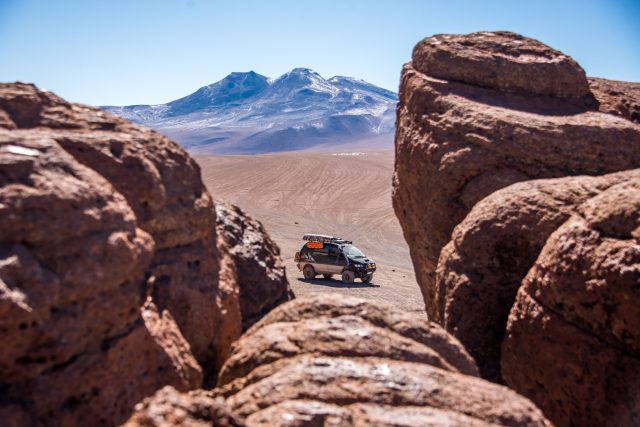
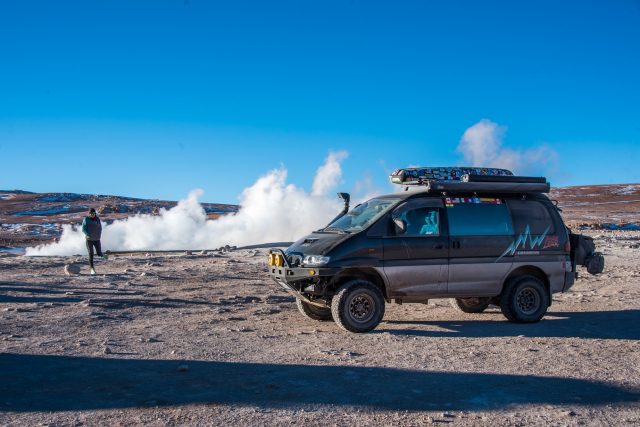
After several key turns and a minor panic attack, we got out our English-translated Mitsubishi Delica van manual (normally, it’s in Japanese). We came up with some educated guesses: either our starter was busted, our diesel was so cold the lines gelled, something was wrong with the glow plugs, or who knew what? Did I mention neither of us is a mechanic? Maybe once the sun got high enough in the sky over this enormous rock tower, finally reaching the hood of our van, we’d narrow down our possibilities. Unfortunately, this was going to take hours. So what to do until then? Well, like most overlanders who have lived on the road for quite some time with their fair share of breakdowns, we’ve learned to make the best of these stressful situations—we either eat or exercise. This time, we did both: 50 burpees at 4,577 meters while waiting for all of our food to defrost in the sun. Then we boiled coffee under the engine block to warm it, but to no avail, so we cooked breakfast. During moments like these, we reflect without really trying; it’s better than freaking out thinking of how the hell you’d even get a hold of a human for a tow truck to get you out of your predicament.
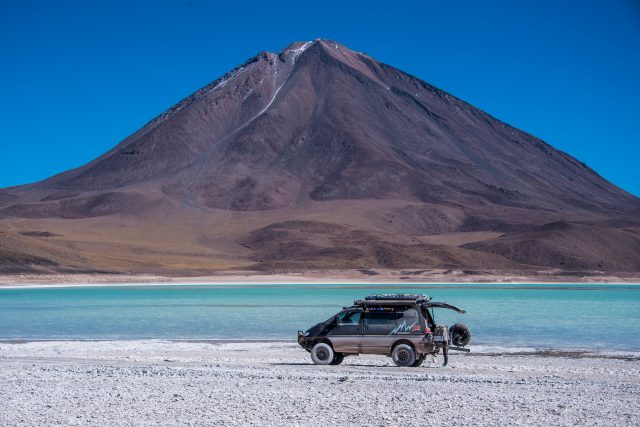
Where were we anyway? The middle of nowhere, aka, the Lagunas Route (or Southwest Circuit, if you prefer). It’s in Bolivia, just east of Chile, and south of the famous Salar de Uyuni salt flats that we had spent the previous week exploring. This is how we would leave Bolivia and cross into Chile, arriving at San Pedro de Atacama to restock. This route was a dream high point that we had been waiting to drive since planning to take off on the Pan-American Highway. Ideally, it would have been with another vehicle or two in convoy, but the timing didn’t quite work out for that. Our path down the western side of this route was roughly 475 kilometers of challenging terrain, harsh wind, freezing temperatures, and passes that take you above 5,000 meters. There’s minimal help out there. You bring all of your food and water, a couple of extra jerry cans of diesel, and you’re off. You will see a good handful of Land Cruisers taking tourists to sights along the route, but we didn’t run into any other solo travelers on our five days in the Altiplano (high plains). This is not your grandma’s Sunday drive (well, maybe for some rad grandmas out there), but in general, this one is a bit of a doozie, and not every vehicle makes it through. The main issues here amongst all of this high desert beauty is terrain and weather. If you’re starting north and heading south into Chile, you begin immediately climbing up sharp rocks, cross some mucky rivers in ravines, drive across soft, deep sand, through geysers, snow, ice, and mini slippery pebbles. Most of the drive is through one of the many deep sand tracks that points in the general direction you are heading. This drive covers it all and puts your vehicle to the test. Enough so, that some navigators like myself are secretly white-knuckling the sides of the seat. I find myself constantly repeating in my head, “Don’t break down, Don’t get stuck, you can do this Bagheera!” gritting my teeth as several mini heart attacks ensue whenever our wheels spin.
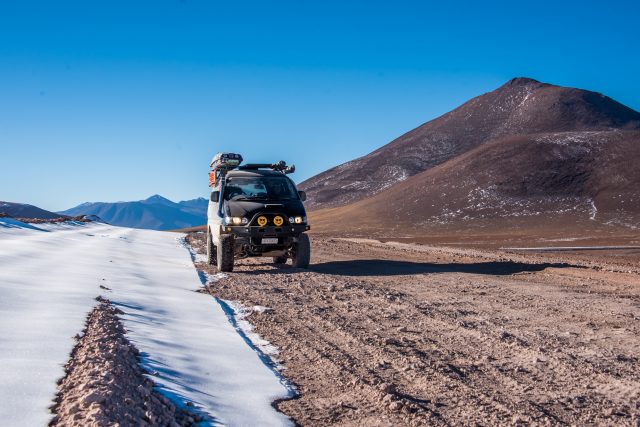
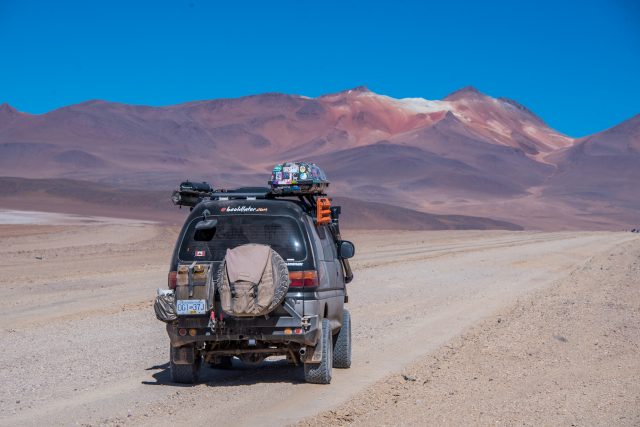
Bagheera is our trusty van beast. He is a 1997 Mitsubishi Delica that we purchased in November of 2016 in Vancouver. Over the course of two years, we converted him into our mini house on wheels, transforming him from a soccer mom van to a life-size micro machine. His name comes from being our guide down the Pan-American highway and making a panther-like growl when you start his engine. We did not adopt “Bags” with the intention of doing this drive down the Pan-American; we saw him as a trusty weekend warrior vehicle with potential. It wasn’t until the day we got married, July 11, 2017, that this decision floated to the top in our sea of what to do next. We were hiking and climbing up the Grand Teton in Wyoming to tie the knot (literally while in our harnesses) on the summit. We found a guide who was ordained online by the Big Lebowski’s Church of Dude who could legally (by the power of the Dude and the state of Wyoming) marry us at the top of the mountain. So, on the way up to this incredible life experience, we discussed what our next big thing would be. Choices included hiking six months on the Great Divide Trail or outfitting the van and driving from the top of North America to the bottom tip of South America. And with that, the dream was alive. We dedicated our weekends and downtime to working on Bagheera at our local wood shop—gutting him, cutting holes in his roof, trying not to lose fingers, or electrocute ourselves. We saved cash for our trip by not going out, cooking at home, and hiking on local trails for fun. We were kept occupied by working toward our goal of getting the van ready to leave June 1, 2018, the day we had to be out of our rental apartment.
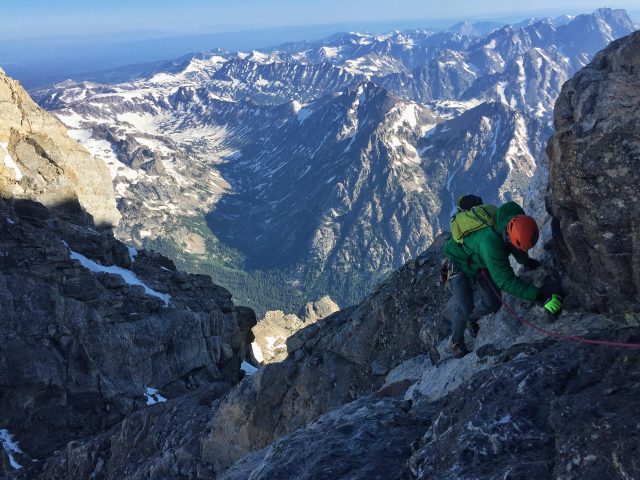
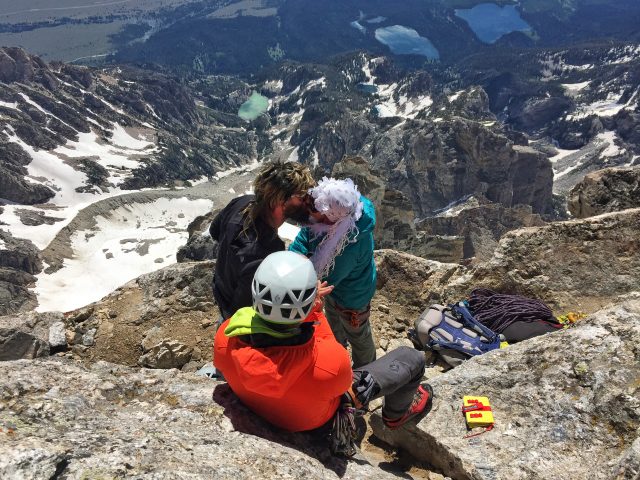
Initially, when you start a trip this big, something you’ve probably never done before, you get stoked on the solitude that awaits you—excited for that loner camp spot in the woods or on the beach. Here you are, finally leaving that city full of people, that city you worked in for over three years with your same weekday routine, friends, and coworkers. You’ve quit your jobs and taken the big step to go forward on this journey, dreaming of the isolation and space that you want away from people and society. We felt that we would meet people of other cultures and learn about their lives, and that through all the volunteering we were going to try to do, maybe we would find a greater sense of global community. Definitely, but also something else. Something crazy happened along the way, something we did not expect. It turns out you end up meeting incredible people who are doing the same thing you are: seeing the world by vehicle. You find other like-minded overlanders, and you immediately hit it off. It’s often the other people seeking this life of adventure that truly become your tribe, the people that understand you the most. Your best friends are generally not the people in the communities you travel through, but the other travelers that are sharing similar experiences. In hindsight, it makes perfect sense, but it was something that surprised us the most when we first set off looking to get away from our old lives. Overland friends are equivalent to dog years in terms of friendships— you skip ahead seven years like you’ve known them the whole time. We were lucky enough to find golden people such as these on the road and were actually on our way to see them after we finished up the Lagunas Route. Instead, we were stuck waiting for ol’ Bagheera to please, please, please start. There was going to be a total solar eclipse taking place July 2, 2019, in a small latitudinal band just south of us, a once-in-a-lifetime chance we’d be in the right place at the right time. And somehow, five overland couples were coming together to a remote desert GPS spot to celebrate it.

So flash back to our current predicament, here we are back in the desert. We’d popped the hood, tried the propane burner, pushed the van uphill a few inches to get ever closer to that sweet, golden sunshine, and there we waited. We alternated sets of burpees and made a deal that we wouldn’t try to start Bagheera again till we hit 50 each. If we got warmed up, maybe he would too. Then on the 20-somethingth try, a cloud of black smoke spit out behind him as he struggled to keep his RPMs up. He sounded like hell, but he was coming back to life. The Lagunas Route was back on track!
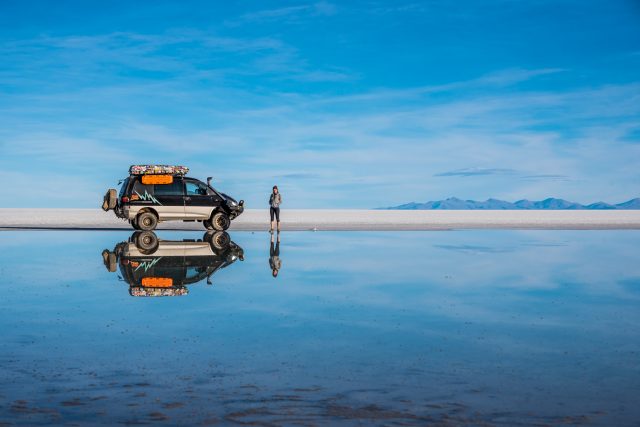
We spent the next two days covering the rest of the route that would be our final farewell to Bolivia. We met some aggressive ballsy foxes, made pancakes in front of a bus of Bolivian tourists who were hogging the hot springs, walked super close to some bubbling hot geysers, and ate peanut butter and jellies by ancient volcanoes. The dark pink mountains, teal lakes, muppet-like flamingos, and ever-changing rugged terrain were some of the many memory gems we took from these five incredible days. We got our passports stamped from the shed that was the Bolivian customs hut. The men running the place were strictly business, but somehow we charmed them, and suddenly I was drawing their favorite animals on their daily planners: un gato y un leon. But this was nothing compared to the Chilean border entrance which was the next biggest building down the road. These customs officers acted like they hadn’t seen people in weeks; I don’t think many humans cross over into Chile this way. They kindly stopped their ping-pong game to help us out, taking our documents while trying to seem serious. Then it was multiple kisses on each cheek, me drawing caricatures of them on important-looking papers, an offering of cigarettes, and finally, a loud, proud lesson on the subject of the Chilean fútbol chant: “Chi-Chi-Chi-Le-Le-Le-VIVA-CHILE!” We were not allowed to leave until we had perfected it. It was all in good fun, but left us, like so many other times, shaking our heads in disbelief of what had transpired.
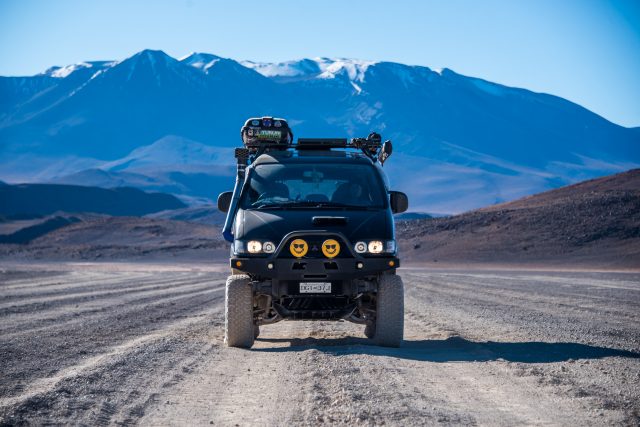
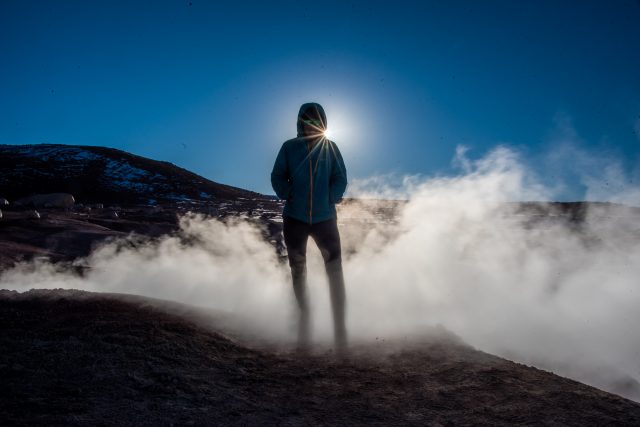
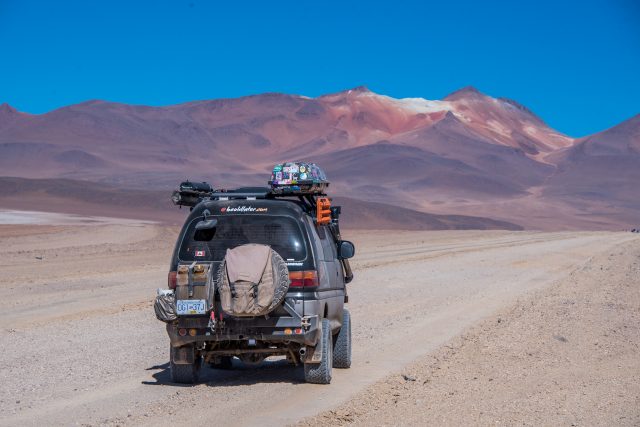
We made it through almost a week of beautiful landscapes and constant challenges. It was one of the most amazing drives of our lives, plus the welcomes across borders with open arms and hospitality made our dream complete. In our minds, we knew our next goal was the eclipse, and we couldn’t wait to share these stories with our friends that we hadn’t seen in far too long. As the GPS waypoint grew closer and we rounded that final lunar dune, we saw four tiny trucks in the distance and the smoke of a campfire. We spent the next couple of days catching up around the fire, sharing meals, telling stories, attempting to catch fish, jamming out to 90’s playlists, and prepping for the total eclipse. The eclipse was supposed to peak around 2:00 p.m., and we only scored two pairs of eclipse glasses to share between 10 people. I decided it would be a good idea to paint everyone’s faces to reflect their spirit animals in preparation for this astrological once in a lifetime event. We looked good, at least I thought so. It was 1:58 p.m. as our mini zoo of overlanders gathered in front of the trucks. Exactly at 2:00 p.m., we all engaged in a synchronized howl as the moon crossed the sun, bringing out the stars for two whole minutes in the middle of the afternoon—what an incredible feeling.
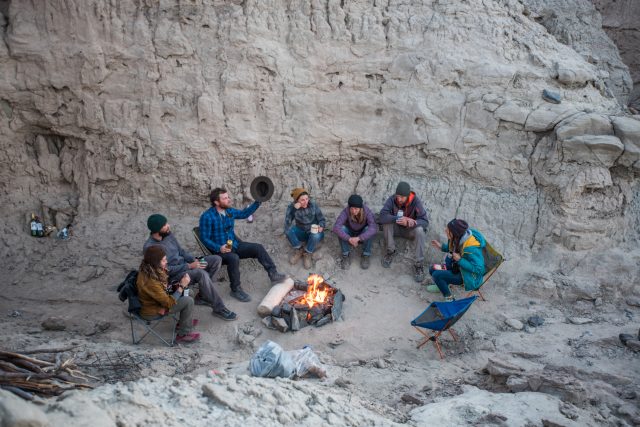
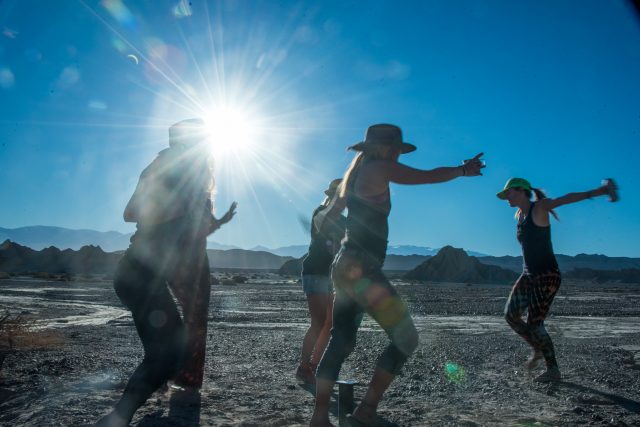
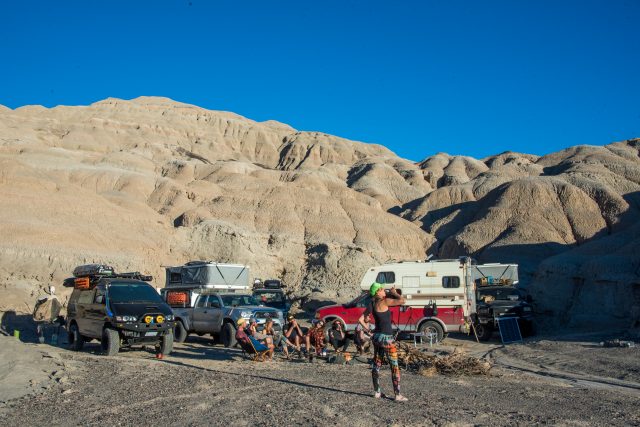
Aside from being one of the best sections of the whole Pan-American Highway, we came to the realization that we had found our community, and we did this by getting out there and living our lives to the fullest. Our tribe is nomadic, friendly, inspired, and courteous. We are equipped to handle a wide variety of problems with a limited amount of tools, and we have amazing stories of adventure and the enjoyment of life to share over beers around a campfire.
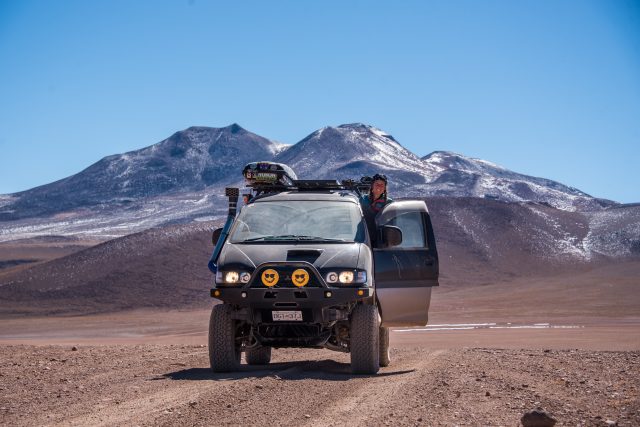
BeOldLater
Candice is a professional artist, nature lover, and an avid volunteer who sees the true importance of giving back. During her travels, she enjoys painting murals and teaching kids how to draw. Jordan is a YouTube-taught van builder. When not exploring the world by vehicle or on foot, he works as a visual effects compositor for films. Over the last 15 years, he’s developed a love for shooting photos instead of just editing them. They both enjoy telling the stories that inspired them to click the shutter in the first place. To them, “be old later” means living life to the fullest here and now and never letting your age hold you back from doing the things that excite you.
